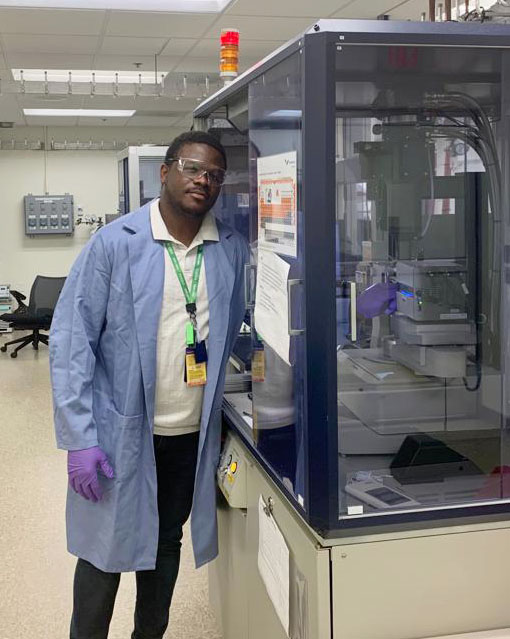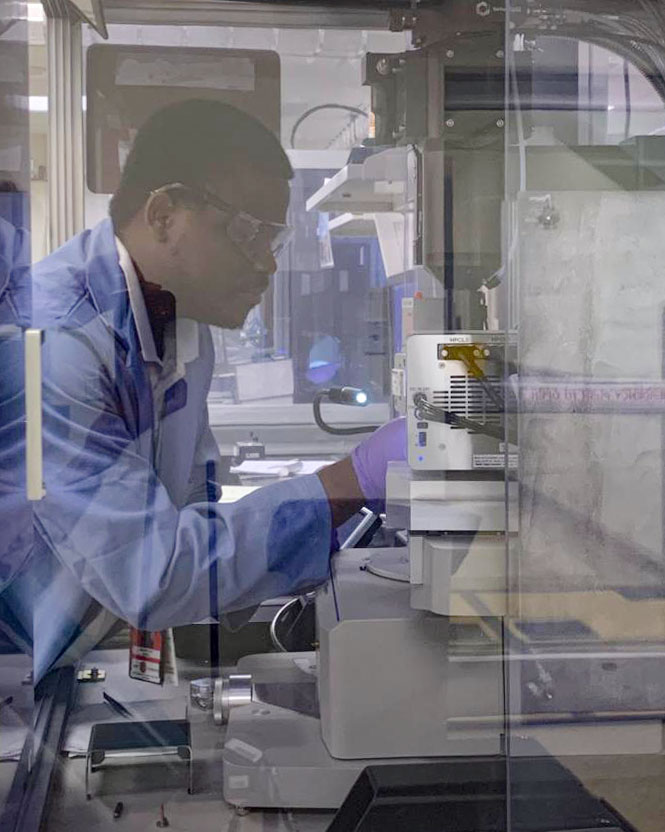Uchenna Ubeh Spends Summer Collaborating with Researchers at Oak Ridge National Lab
When most people think of magnets, decorative pieces that you stick on a refrigerator door come to mind. However, the world of magnets goes far beyond your refrigerator.

Magnets are used in many technological areas, and they take on a wide variety of shapes and sizes. Recently, physicists have discovered magnetic materials that take the shape of two-dimensional layers that are only one atom thick. An example would be ultra-thin magnetic sheets.
“These novel magnets could unlock new technologies and a better way to store data in the future,” said Uchenna Ubeh, a physics Ph.D. student at the University of Houston College of Natural Sciences and Mathematics.
Ubeh is spending four months in Tennessee at the Oak Ridge National Laboratory (ORNL) participating in the first Neutron Scattering Graduate Research Program at ORNL. He is supported by a graduate research fellowship funded by the U.S. Department of Energy.
The fellowship allows Ubeh to use state-of-the-art technology while working with his UH mentor, Byron Freelon, assistant professor of physics, and ORNL mentor, Christina Hoffmann, senior neutron scattering scientist. Ubeh’s project also involves working with world-renowned physicist Robert Birgeneau and his team from the University of California, Berkeley, to further the research of magnetic materials and their properties.

In addition to access to the ORNL world-class national research facility, the fellowship includes a monthly stipend and reimbursement for round-trip travel expenses.
Exploring How Stress Affects Magnetic Material
Ubeh said our ability to use two-dimensional magnets will depend on how they interact with neutrons. That’s because neutrons are used to determine the details of magnetic properties of all kinds of materials.
“Physicists typically use a technique called neutron scattering to determine how small, microscopic magnets are arranged in material,” said Freelon. “This same experimental work needs to be performed on newly discovered two-dimensional magnets.”
At ORNL, scientists are examining how magnetic material behaves when it is stretched or squeezed. They use a powerful tool known as a neutron spallation source that provides neutron beams. The neutron particles are used to reveal how a material’s magnetism responds to being strained.
“It’s like examining a sheet of paper, only with unique magnetic properties,” said Ubeh.
He is developing experiments that allow the thin magnetic sheets to be pulled. During the process, neutrons will be projected into the material. The neutrons that scatter off will be studied.
The tiny neutron particles that scatter from materials can give scientists important details about the atomic structure and magnetism.
Researchers at ORNL previously discovered how the two-dimensional material became more sensitive to magnetic fields when put under strain. They found some particles inside the material appeared to “dance” in response to the strain.
Laying the Groundwork for More Efficient Technology
While at ORNL, Ubeh’s research focuses on the result of applying mechanical strain to chromium sulfur bromide, which is known as a van der Waals antiferromagnet. Ubeh is exploring the strain on the material at an atomic level when exposed to a neutron beam.
“My research aims to achieve a better understanding of chromium sulfur bromide’s magnetic properties and controlling them,” said Ubeh. “A better understanding could lead to new technology devices and information storage systems.”
Ubeh is exploring the magnetic properties of chromium sulfur bromide through neutron diffraction techniques. These techniques are used to help scientists better understand magnetic properties which are unseen by the human eye alone.
“In diffraction, the neutrons don’t simply pass through a material,” said Ubeh. “Instead, once the neutrons hit magnetic material, they change direction based upon the specific arrangement of electron spins within the material.” This process is known as neutron scattering.
By determining the direction of scattered neutrons, physicists can extract a large amount of information about how electron spins behave within two-dimensional magnets.
The high price tag of the experimental equipment required to conduct neutron diffraction studies puts limitations on how and when scientists can conduct these studies. The equipment can only be found at national laboratories, like ORNL, which is why Ubeh’s fellowship presents a unique opportunity.
“I am fortunate to be one of the few researchers to have access to these lab tools so I can advance my research in magnetic materials,” said Ubeh.
Chromium sulfur bromide achieves its antiferromagnet classification when the material is cooled to a low temperature, causing its chromium atoms that act as tiny magnets to align opposite of each other. This is similar to two magnets pulling away from each other when trying to stick them together.
“This magnetic material is held together by weak forces known as van der Waals forces which occur between layers,” said Ubeh. “The forces allow the layers to have very weak coupling, giving them unique properties.”
Future Possibilities for Chromium Sulfur Bromide
Ubeh joins a growing number of scientists who are interested in chromium sulfur bromide due to its potential applications in quantum computing and advanced technology.
These applications could lead to more efficient supercomputers that use less energy to cool and contribute to cleaner air.
“I appreciate the research opportunity presented to me through the fellowship that will benefit not only me, but also the UH research community,” said Ubeh.
Ubeh’s fellowship runs through September 30.
- Chris Guillory, College of Natural Sciences and Mathematics